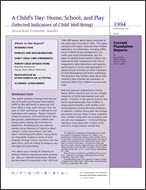A Child's Day: Home, School, and Play (Selected Indicators of Child Well-Being): 1994
A Child's Day: Home, School, and Play (Selected Indicators of Child Well-Being): 1994
Introduction
This report presents findings from the Survey of Income and Program Participation (SIPP) on the well-being of American children. While it may seem intuitive, the concept of child “well-being” is difficult to conceptualize and measure. Recent research primarily assesses child well-being for two age groups: preadolescent children and young adults making the transition to adulthood. Preadolescents are often assessed using measures of cognitive development, social environment, and time spent interacting with adults. Young adults are frequently studied in terms of their progress through school, transition into the labor force, and the timing of entrance into marriage and parenthood.
This report uses a variety of indicators to portray children’s experiences while growing up. Data on child well-being were collected by interviews of households in the 1992 and 1993 SIPP panels, which were conducted at the same time in the fall of 1994. The topics covered in this report illustrate what children experience on a daily basis, including differences in family living arrangements, economic and social environments, and the types of neighborhoods where children live. Experiences with nonparental child care arrangements, daily interactions with parents, performance in school, and participation in extracurricular activities are other indicators of child development and future well-being. The decisions that families make about their children’s daily activities are important, as many will affect their children’s success over time.1
Previous research established a link between family structure and various related measures of child development and well-being.2 Children in two-parent families fare better developmentally than children in single-parent families, with children of divorced parents having the most problems. In addition, children living with two biological parents are less likely to have problems than children living with one biological parent and one stepparent.3 Child well-being indicators associated with children of divorced or single parents include low measures of academic achievement (repeated grades, low marks, low class standing), increased likelihood of dropping out of high school, early childbearing, and increased levels of depression, stress, anxiety, and aggression.
Familial stress associated with marital conflict and divorce can negatively affect a child’s development.4 Diminished contact with the noncustodial parent can result in a loss of emotional support and supervision from adults. Children of single parents generally have a lower economic standard of living and more frequently participate in government assistance programs than do children from two-parent families.5 All of these circumstances have a cumulative effect on the way children grow up and how they are prepared for young adulthood.
_______________
1 To isolate the contribution of individual factors that are related to behavioral outcomes for children, one would need a multivariate analysis which would control for the effect of many factors simultaneously; this type of analysis has previously been conducted for some of the topics covered in this report. See Jason M. Fields and Kristin E. Smith, Poverty, Family Structure, and Child Well-Being: Indicators From the SIPP, Population Division Working Paper Series, No. 23, U.S. Census Bureau, Washington, DC, 1998.
2 Robert Hauser, Brett Brown, and William Prosser (editors), Indicators of Children’s Well-Being, Russell Sage Foundation, New York, 1997.
3 Sara McLanahan and Gary Sandefur, Growing Up With a Single Parent: What Hurts, What Helps, Harvard Univer-sity Press, Cambridge, MA, 1994.
Others in Series
Publication
Publication
Publication




